|
Belly Up to the Cocktail Bar
by
Bob Brooke
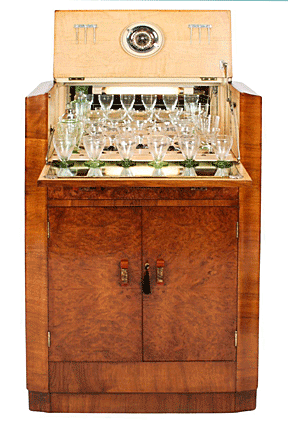 Unlike
other furniture, such as chairs, beds and dining tables, the home bar is
a recent invention. At its core, is a counter from which drinks could
served. Unlike
other furniture, such as chairs, beds and dining tables, the home bar is
a recent invention. At its core, is a counter from which drinks could
served.
From the 1800s, pubs spread around Europe. In United States, they became
known as saloons. During this period of industrialization, there was a
rise in commercial brewers—then public drinking followed the trend.
These bars became an important part of working class life, because
patrons could also take a break there and socialize with their friends.
During the same era, it wasn’t unusual for wealthy home owners on both
sides of the Atlantic to have elaborate, lockable cabinets for storing
their valuable bottles of spirits. Similar cabinets would become part of
the home bar design decades later thanks to Prohibition.
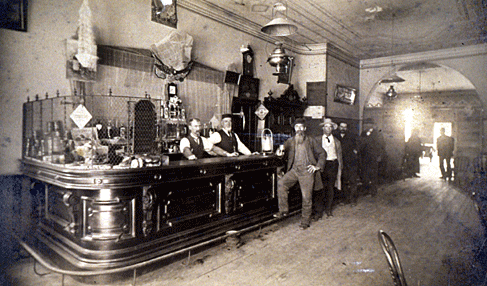
The American
anti-drinking movement of the 1910s, which eventually culminated in
Prohibition in January 1920, spelled the end of saloons. It became
illegal to make or sell alcohol. But just like the prohibition of most
substances, the laws were inconsistent. In many places, the mere
ownership of alcohol was a crime but elsewhere laws allowed people to
drink in private houses and clubs, so those who didn’t have the means or
courage to find booze to purchase could drink at home.
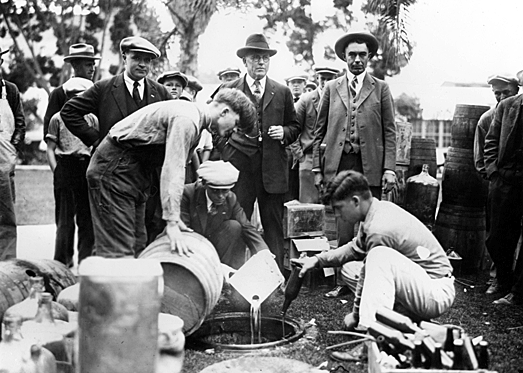
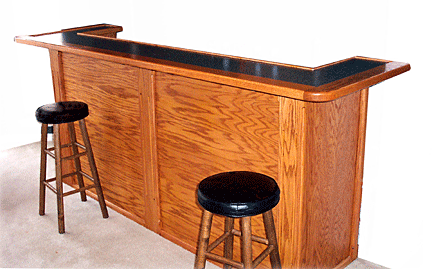 Whether
homeowners were running bootleg operations or just hosting their friends
to drink with them, booze was the center of focus, rather than the
furniture. It was a simple and temporary operation. Why purchase
expensive furniture when cops might raid the place at any point and shut
it down? Most homes didn’t have bar furniture and the ones that did, had
only simple wooden bars. Whether
homeowners were running bootleg operations or just hosting their friends
to drink with them, booze was the center of focus, rather than the
furniture. It was a simple and temporary operation. Why purchase
expensive furniture when cops might raid the place at any point and shut
it down? Most homes didn’t have bar furniture and the ones that did, had
only simple wooden bars.
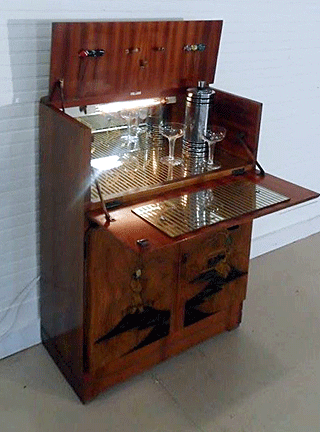 Before
Prohibition, there was no need to recreate the classic pub look and
experience at home. That changed during the 1920s. The modern home
cocktail bar started as a genuinely American act of rebellion.
Ultimately, the home bar “pub experience” would temporarily disappear,
but would eventually return with great success in the 1950s and 1960s. Before
Prohibition, there was no need to recreate the classic pub look and
experience at home. That changed during the 1920s. The modern home
cocktail bar started as a genuinely American act of rebellion.
Ultimately, the home bar “pub experience” would temporarily disappear,
but would eventually return with great success in the 1950s and 1960s.
The advent of home cocktail bars just happened to coincide with the Art
Deco Movement. Many types of furniture appeared as part of the Art Deco
Movement in the 1920s through the 1930s. A good example was the Art Deco
cocktail cabinet, which was meant to hold all the items needed to make
cocktails. These cabinets contained alcohol, other cocktail ingredients,
glassware, and other accessories. Like other furniture pieces made using
that style, the cocktail cabinets emphasized a sense of sophistication
and luxury. They were made from mahogany and included materials like
plate glass, chrome, and Bakelite. Manufacturers lacquered wooden
surfaces with resins to make them hard and shiny.
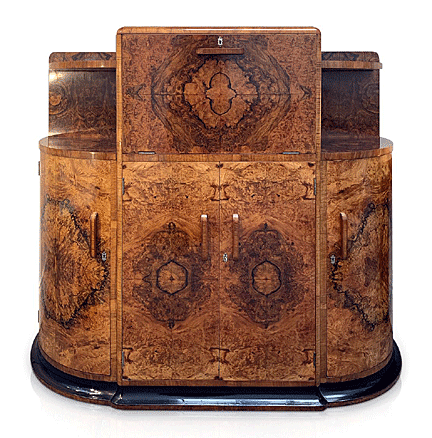 Art
Deco design featured geometric shapes of all kinds. There was an
emphasis on vertical lines and streamlined surfaces. Mostly, designers
employed high contrast and bold colors. Elements borrowed from machines
such as automobiles, trains, and airplanes, can also be seen on Art Deco
cabinets. At that time, furniture was purposely created to fit into a
given interior. Art
Deco design featured geometric shapes of all kinds. There was an
emphasis on vertical lines and streamlined surfaces. Mostly, designers
employed high contrast and bold colors. Elements borrowed from machines
such as automobiles, trains, and airplanes, can also be seen on Art Deco
cabinets. At that time, furniture was purposely created to fit into a
given interior.
Parisian department stores began to stock cocktail sets, light fixtures,
and large pieces of French Art Deco furniture, including richly
appointed cocktail bars. Customers could walk into the shops and buy
whatever piece of furniture they needed in their homes.

Designers used different types of wood to make furniture. Examples
include mahogany, zebrawood, and ebony. Sometimes, thin wood layers
covered the furniture surfaces. Some designers would use natural grains
to emphasize the linear aspects of a piece of furniture. In some cases,
there were subtle curves without making a piece of furniture heavy or
bulky. As additional decoration, designers used ivory inlays of animate
and plant figures. Alternative materials for inlays included
mother-of-pearl and brass.
Art deco furniture designers sometimes used modern materials like chrome
and aluminum. Manufacturers used these metals on cabinets, chairs, and
dressers to create mirror-like shiny surfaces.
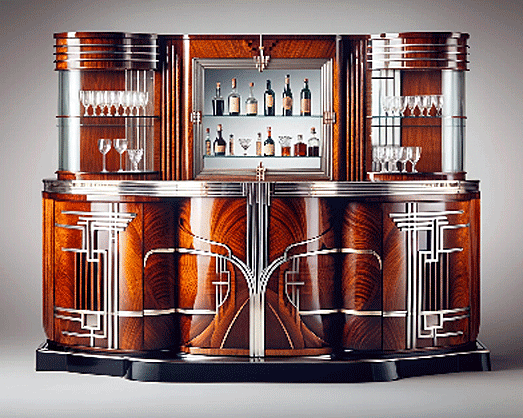
Drinking in the Post-Prohibition Era
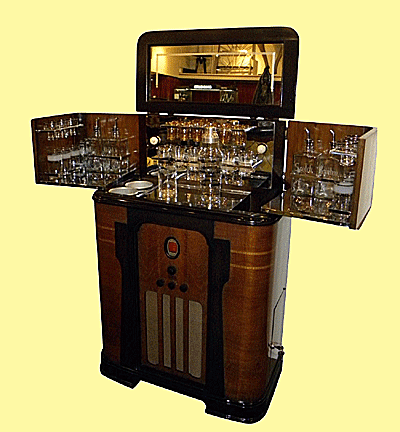 Prohibition
officially ended in 1933, and over the rest of that decade new
inventions emerged. In 1937, a brilliant convergence of traditional
craftsmanship, technology and art happened when the American radio
company, Philco, released a radio that opens up into a cocktail cabinet.
This Art Deco-inspired “Radiobar” was available in ultra-modern
materials like aluminum, chromium and Bakelite. Only few could afford
it. Imagine how futuristic and prestigious it was to have that Radiobar
in your home in the 1930s! Prohibition
officially ended in 1933, and over the rest of that decade new
inventions emerged. In 1937, a brilliant convergence of traditional
craftsmanship, technology and art happened when the American radio
company, Philco, released a radio that opens up into a cocktail cabinet.
This Art Deco-inspired “Radiobar” was available in ultra-modern
materials like aluminum, chromium and Bakelite. Only few could afford
it. Imagine how futuristic and prestigious it was to have that Radiobar
in your home in the 1930s!
If the Radiobar was exclusive and unaffordable to most homes, another
item was available in a wide range of sizes and prices. Furniture makers
converted the Victorian tea trolley into a cocktail cart, which is a
portable mini-bar on wheels. Unlike cabinets, it could be wheeled around
from one room to another, even on to the terrace or balcony. However,
they didn’t reach their peak in popularity until the 1950s.
The 1950s: The Home Bar Becomes Part of
the American Dream
After the Second World War, the rising suburban middle class enjoyed one
of the most prosperous periods in American history. Since life in the
suburbs was far from the nightlife of clubs and bars, families aimed to
enhance their in-home entertainment,
Beyond the expensive car and the big house with perhaps a swimming pool,
if women could enjoy new luxuries in the kitchen like a refrigerator, a
freezer and even a dishwasher, then men could buy a home bar to enjoy a
drink or two after they came home from work.
<
Back to Antiques Archives
Next Article > |
